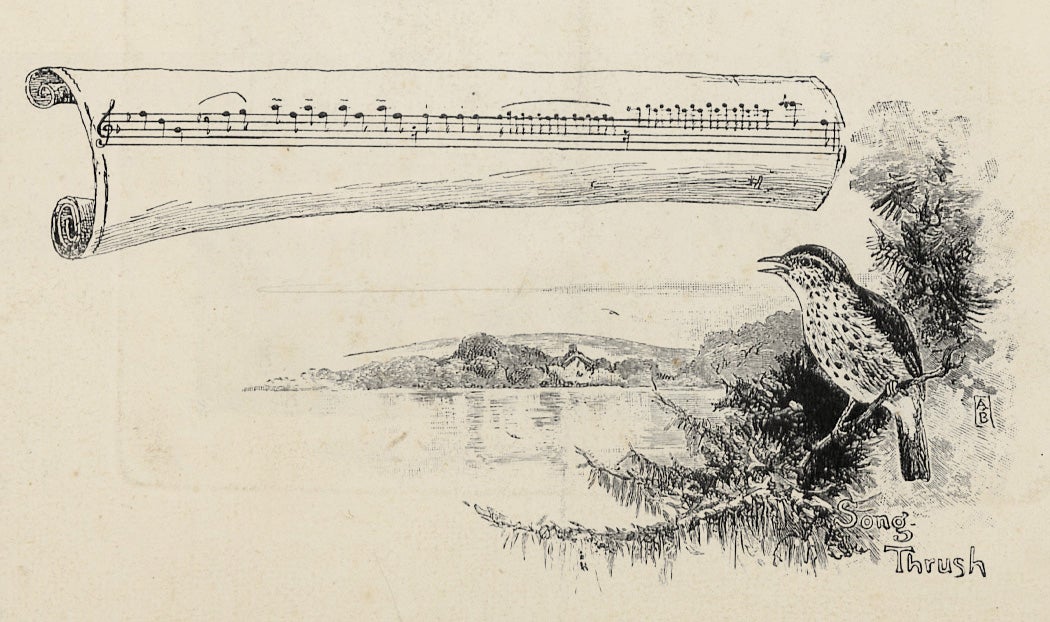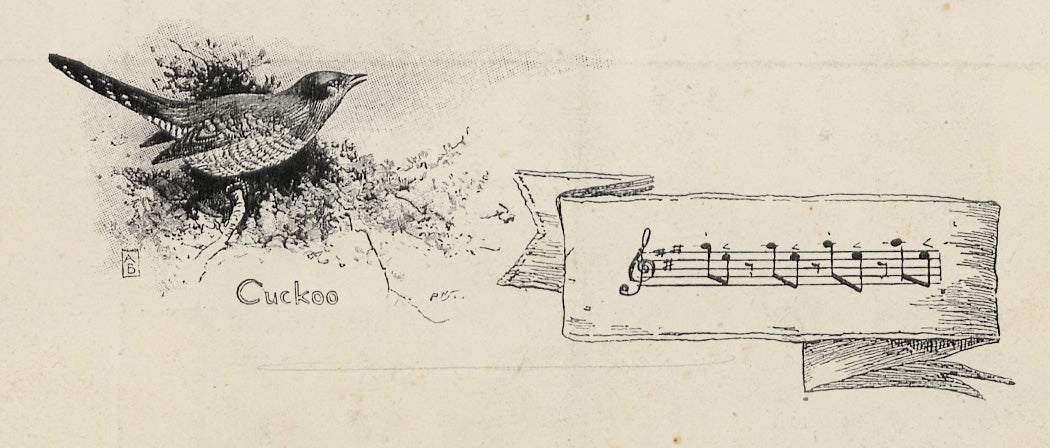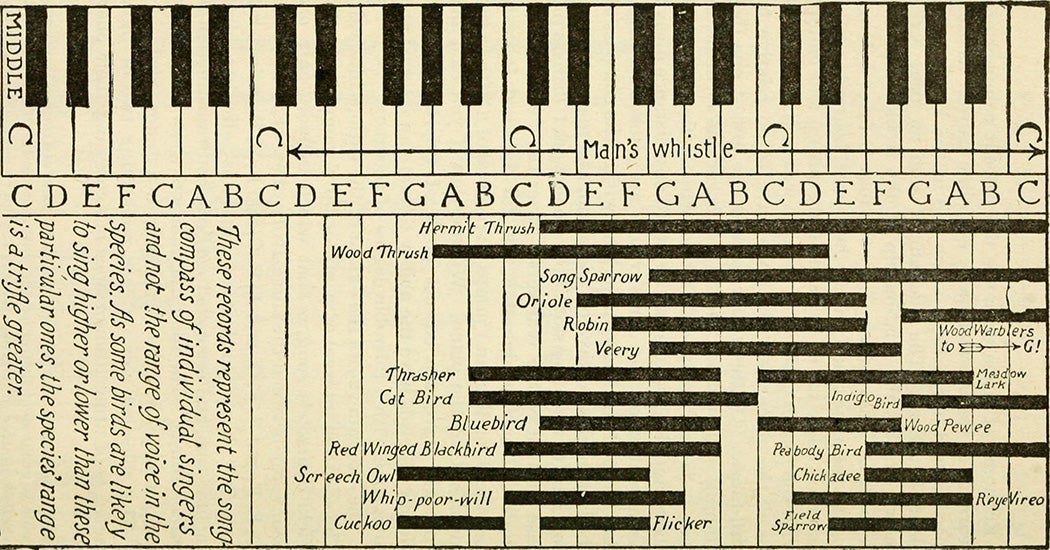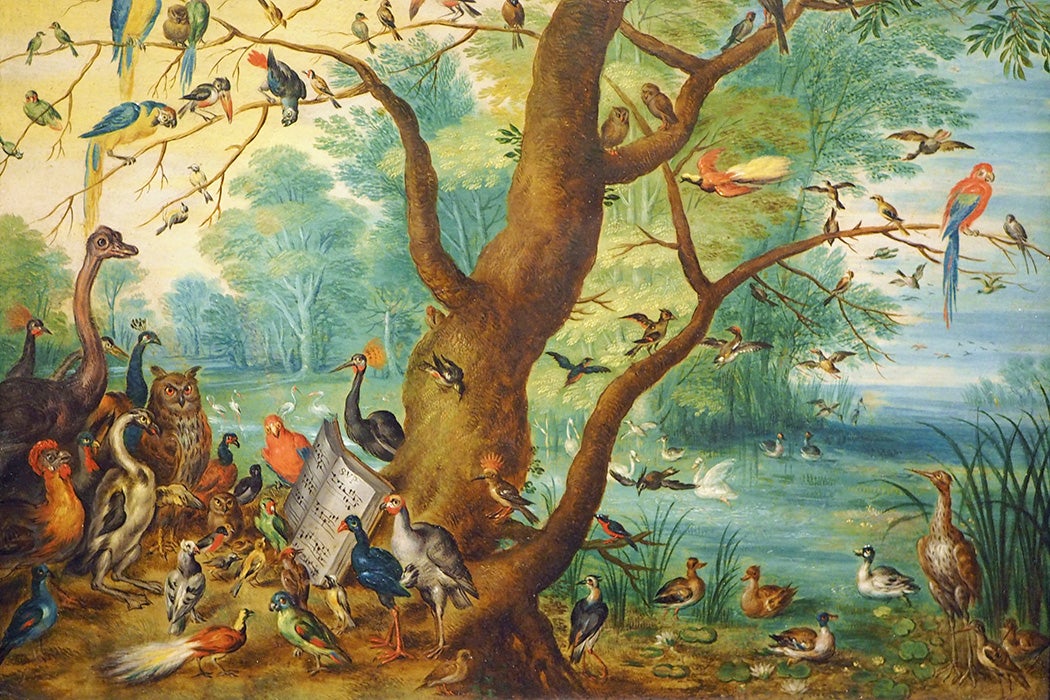To some extent, we all know music when we hear it: a melody, a rhythm, a progression of individual notes that, taken together, elevates the whole into the realm of auditory art. Like any art form, we define it partly by the method of its construction—a painting is painted, a song sung—and also by its effect on us. If something sounds like music, it is. But what about songs sung by non-humans? Is birdsong music?
The question isn’t new. As far back as Aristotle, philosophers, scientists, and musicologists have argued over the musicality of the avian world. Medieval writers often dismissed birdsong as “vox inarticulata,” a category of sounds that may be enjoyable but lack meaning or intention. Meaning and intention were, to them, the exclusive domain of humanity and God. St. Augustine agreed, claiming that birds lacked the rationality necessary for true creation. When birds were associated with a “true” voice in European art and literature, it was often as the voices of angels, themselves depicted with the feathered wings of birds.
Weekly Newsletter
One hundred years ago, in 1922, the American musician and scholar W. B. Olds contributed to this debate with “Bird-Music,” an essay whose very title itself demonstrates his position. Olds makes the case that not only is birdsong music, but it’s uniquely beautiful and powerful. To him, each species of bird is a star in its own right, and he gives special mention to a few common American birds; the field sparrow’s song is “a perfect accelerando,” while the song of the white-throated sparrow compels him to ask, “Where is there to be heard a finer legato or more definite rhythm?” Above all, Olds seems most inspired by the tiny ruby-crowned kinglet: “It seems scarcely believable that such a cascade of sparkling tones, extremely high in pitch but wonderfully clear, could proceed from so small a throat. The musician who has not heard it has something to live for.”
The format and timing of “Bird-Music” are important to consider. Olds presents his subjects’ songs not in sonograms (the soundwave format often used to visualize birdsong) nor in the often clunky pronunciation found in bird identification guides (“rat-shrrow!”). Instead, he charts them on standard musical scales. He notes that at the time of publication, musical notation like this had only recently begun to be widely taught to students, not just in private music academies but in public schools. His tablature would be familiar, and even playable, by any young piano student today. Every good bird does fine, if you will.
Olds has a contemporary ally in Hollis Taylor, a zoomusicologist and composer. In Is Birdsong Music, from 2017, she lays out the evidence accumulated since “Bird-Music,” from both the scientific and musical canons. Her conclusion is clear: “To withhold the label music from birdsong is outdated and arrogant.”

Taylor takes a special interest in the birds of her adopted home of Australia. In her 2010 article “Blowin’ in Birdland: Improvisation and the Australian Pied Butcherbird,” she centers on one particularly innovative species. The butcherbirds in the study not only show an incredible array of sounds and rhythms, but importantly, they also differ significantly from each other. Two Tree and Wordsworth, two of the study’s star birds, are as different as any two performers could be. Not only do we see evidence of music, but of individual musicians, a clear challenge to any anthropocentric worldview that would see ours as the only voices with intention.
Taylor’s focus on improvisation drives home the important point that birds do not simply listen and repeat. Some individuals are certainly more innovative than others, and some more strict traditionalists, but is this not also true of human musicians? Taylor uses the term “Klangfarbenmelodie,” literally in German “sound-color melody,” to describe one of the butcherbird’s approaches to song. Arnold Schoenberg coined the term Klangfarbenmelodie to describe his favored method of dividing a sound between two or more instruments, a mixing and recombining of musical elements that produces something altogether novel.

One of the study birds in particular, Wordsworth, seems to be Schoenberg’s kind of creature. Taylor sees him in the same category as some of the great jazz and rock innovators. “Klangfarbenmelodie is an apt description of the ‘sound’ of many improvisers, such as Derek Bailey, Paul Lovens, John Butcher and Jim Denley, and also seems an appropriate description of Wordsworth’s typical vocal approach,” she says.
Appreciation of music is global, touching every culture. Its universality should serve as a critical reminder not to privilege European definitions and understandings of music and musicality. The people in the Wassoulou region of West Africa celebrate the relationship between human music and birdsong while recognizing its complexity. One type of revered singer in Wassoulou is the kònòw, literally songbird. The kònòw is always a girl or woman who sings in a high voice reminiscent of birds. But this isn’t a straightforward point for the pro-music contingent. For all their appreciation and reverence for birdsong, it is clearly delineated from human music in their language. People dònkilida (sing), while birds kasi (cry).
The case for avian musicality is old and strong. But some researchers see the development of human speech as a more useful analogue to birdsong than music.
In 2003, University of Washington speech and language development expert Patricia Kuhl published a commentary in the Proceedings of the National Academy of Sciences titled “Human Speech and Birdsong: Communication and the Social Brain.” Investigating from the angle of learned behavior, she argues that different birdsong lineages are more similar to human languages than to our musical traditions.
“For babies, the task [of learning sounds] involves committing to memory the phonetic units and prosodic (pitch and intonation) characteristics that typify the mother tongue: Japanese is not French,” Kuhl explains. “Birds store the specific notes, syllables, and prosodic characteristics that typify their species.”
We now know that the similarities between birdsong and human speech go much deeper than behavior. They’re encoded in our DNA. There’s a gene common to many vertebrates called FOXP2. By studying people with FOXP2 mutations, we know that correct transcription of this gene is necessary for the development of proficient speech. As it turns out, birds with abnormal FOXP2 genes experience a similar effect: They cannot learn to sing properly.

But one fact of bird physiology complicates this connection. Humans speak—and sing—using the larynx, an organ that we share with all other vertebrates. Birds, too, have larynxes, but they don’t sing with them. Instead, they use a syrinx, an organ unique to birds. For centuries, anatomists and ornithologists have theorized that the syrinx acts more like an instrument than a voice box. Some have compared it to a french horn, others to an oboe. Scientific consensus has shifted back and forth about this over the years (see Stephen Nowicki and Peter Marler’s “How Do Birds Sing?” for a good recap), but the more we learn about birdsong and the creatures composing it, the more it seems to fall between voice and instrument, with characteristics of, and differences from, both.
There’s a third interpretation worthy of note. If birdsong shares functional and aesthetic similarities to music and developmental overlap with speech, maybe its most meaningful analogue in humans is the place where those two domains meet: poetry.
Virginia Woolf placed birds and birdsong prominently in all of her novels and most of her shorter works, an obsession that went deeper than her fiction. In one of her final, unpublished essays, “Anon,” she theorizes that all lyrical poetry, and indeed literature itself, began with human interpretation of birdsong. It’s a bold claim, but there are others who also see a deep connection between the two.

In his article “Sing and Be Heard: Birdsong and the Romantic Lyric,” Onno Oerlemans sees not only the beauty and rhythm of poetry in birdsong, but goes a step further. In a direct challenge to “vox inarticulata,” he writes, “The significance of birdsong is not only the anthropomorphized symbols we create from it, but in the pattern, beauty, and even meaning the songs themselves might already contain.”
Oerlemans is clearly as fascinated by birdsong as Olds and as well-read a student of birds as Taylor. He calls the connection between birdsong and poetry “a deep homology, phenomena with parallel rather than linked evolutionary histories.” Where Woolf saw human lyrical poetry growing out of birdsong, Oerlemans sees them arising separately, each in their own host species, in their own times and for their own reasons.
“Birds sing to be noticed by and to influence other birds,” writes Oerlemans, “as poets do for readers and other poets. However, they also sing after mating is over, after fledglings have left, after it serves any identifiable biological purpose, as though they must express themselves.”
Scientific readers may scream “Anthropomorphism!” in damning retort. For decades, scientists bent over backward to avoid even the appearance of attributing human characteristics to animals. But that mindset is slowly changing. Frans de Waal, one of the most accomplished researchers and authors in animal behavior, argues that anthropodenial is an equal and opposite logical mistake. To assume animals are motivated by the same inner life as humans is an obvious error. But to assume the opposite, that animals are simply biological robots led by instinctual programming, rather than beings with minds—different minds than ours, surely, but minds that are more similar to ours than they are to machines—is equally illogical. Animals play. They form bonds with allies and recognize foes. Is it so hard to imagine, given the abundance of evidence, that they also create, in a way separate but parallel to the way we do?
Weekly Newsletter
Birds are one of the most visible signs of the coming calamity—the Earth’s sixth mass extinction. In North America alone, it is estimated that there are three billion fewer birds today than there were in 1970, a loss of almost one in four. W. B. Olds’ field sparrow, the one with the “perfect accelerando,” is still relatively easy to see and hear in its range, but some estimates have put its decline at fifty percent in the last fifty years. Whether birdsong is music, speech, or poetic verse, there is simply far less of it than there used to be. Rachel Carson wrote her classic Silent Spring in 1962, and even though many of the most dramatic cases of bird decline, such as raptor nesting failure due to DDT, have been reversed, the trend for birds overall has continued. The spring is arguably quieter now than it was when she sounded the alarm.
If we saw birds as musicians, each with individual voices and skills, would we be more likely to act to conserve them? If we heard speech in their songs, rather than squeaks and whistles, would that stop us from cutting down a tree or expanding a parking lot? We may never know what birdsongs mean to birds, but we have a limited amount of time to decide what they mean to us, and what we are willing to do to keep them in our world.







